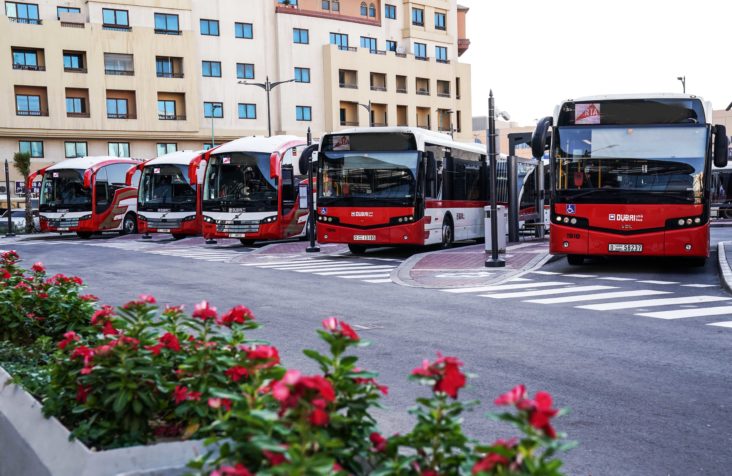461 Million Riders Used Mass Transit Means, Shared Transport And Taxis In 2021

Dubai’s Roads and Transport Authority (RTA) announced that the number of riders using public transport, shared transport, and taxis in Dubai, which include the metro, tram, public buses, marine transport means (abras, ferry, water taxi, water bus), e-hail vehicles and taxis (Dubai Taxi and franchise companies) in 2021 amounted to about 461 million riders.
The number compares well with the number announced in 2020 amounting to about 346 million riders. The daily average of riders using mass transit means and taxis last year reached 1.3 million riders, compared to about 948,000 riders daily average reported in 2020.
“The Dubai Metro and taxis accounted for the biggest share in the number of riders using public transport, shared transport and taxis, with a share of 34% for taxis, and 33% for the Dubai Metro. Meanwhile, the share of public buses amounted to 25 percent of the total number of public transport commuters. December 2021 recorded the highest number of public transport users with 53 million riders, followed by November recording 50 million riders. The number of riders in each of the remaining months ranged from 30 to 48 million riders,” said Mattar Al Tayer, Director-General, Chairman of the Board of Executive Directors of the Roads and Transport Authority.
“These results confirm that public transport operation is back to normal following Covid-19 and is a reflection of the high confidence of public transport users in the efficiency of the preventive and precautionary measures that RTA had initiated to curb the spread of the pandemic right from the start. RTA applied the best global practices in coping with the virus. Such efforts were rewarded by a certification of the Covid-19 prevention measures from the Norwegian DNV.GL company; one of the prominent international entities in the evaluation of the infection control programmes and associated risk management, including performance-related health and preventive measures. RTA’s efforts also accelerated the recovery of the public transport sector and restored the normal business to pre-Covid-19 levels. They have also boosted the confidence of public transport riders in the efficient health and preventive measures taken to protect public transport riders and the staff of public transport means, stations and related facilities,” added Al Tayer.
“The number of metro riders on both the Red and Green Lines reached 151.3 million riders in 2021. Burjuman and the Union Stations (transfer stations on the Red and Green Lines) accounted for the biggest number of metro riders last year. About 8.8 million riders used Burjuman Station on both the Red and Green Lines, and the Union Station was used by about 7.5 million riders on both the Red and Green Lines,” said Al Tayer.
“On the Red Line alone, Al Rigga Station witnessed the highest number of riders as it was used by as much as 7 million riders, followed by the Mall of the Emirates Station (6.3 million), Business Bay Station (5.8 million), and Burj Khalifa-Dubai Mall Station (5.7 million). On the Green Line, Baniyas Station topped the list in terms of the ridership numbers by lifting about 5.3 million riders, followed by Sharaf DG Station (5.1 million), the Stadium Station (3.9 million), Salah Aldin Station (3.8 million) and Al Ghubaiba Station (3.2 million).
Last year, Dubai Tram carried 5.34 million riders, public buses served 116.3 million riders and marine transport means (abras, water bus, water taxi and the ferry) lifted 10.94 million riders.
Last year also, shared transport means (e-hail vehicles, and smart rental vehicles) were used by 22.9 million riders, and taxis (Dubai Taxi and franchise companies) lifted 154.7 million riders.
“These results highlight the efficiency of RTA’s plans and programmes implemented to provide diversify mobility options for people in the emirate. Dubai’s public transport network, which is fully integrated, has become now the backbone of people movement around Dubai. The network succeeded in coaxing a change and evolution in the culture and attitudes of all community segments to the use of public transport means,” noted Al Tayer.
“RTA’s strategic and executive roads and transport plans are built on the principle of integration. As such, the smooth mobility and flow of traffic in the emirate hinge on the provision of integrated solutions for broadening and improving the networks of roads, crossings and all elements of mass transit means including the metro, tram, buses, marine transport and the first and last-mile mobility means. They also depend on the improvement of facilities for pedestrians and cyclists and upgrading the technological systems in use in traffic, roads and public transport. They also cover the implementation of policies capable of limiting the public reliance on private vehicles and increasing their reliance on other mobility means including public and shared transport.


